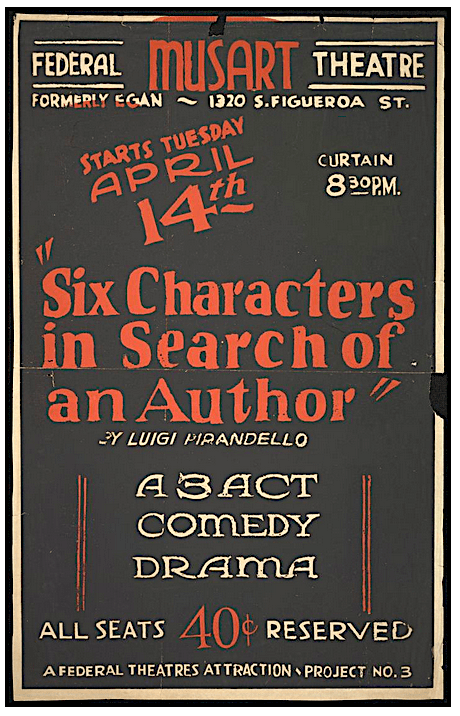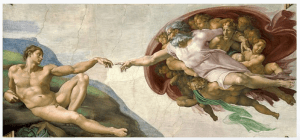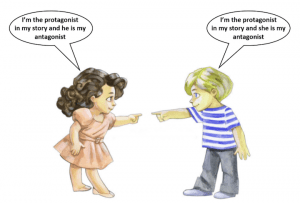 One review of The Gray Man says, “The Gray Man is a story about assassins who are, we’re told, the very best in the world. And yet over and over again, they are shown to be shitty at their jobs. They incite international incidents. They wage small wars in town squares. And they have a very hard time holding a small girl hostage.” The reviewer, Joshua Rivera, notes that the plot for The Gray Man is tried and trite; of a protagonist who’s boss seeks their demise, as in The Bourne series. It is so easy to fall into a plot like this and (shh, just our secret) I almost did this the other day too. I prefer simple plots with complex endings that surprise the reader, but would never want you to know this. [Postscript: This movie is full of action—so much so, that one popular review says, “Sometimes it seems like everybody in hollywod (sic) has forgotten that things don’t have to happen on a massive scale to be interesting.”]
One review of The Gray Man says, “The Gray Man is a story about assassins who are, we’re told, the very best in the world. And yet over and over again, they are shown to be shitty at their jobs. They incite international incidents. They wage small wars in town squares. And they have a very hard time holding a small girl hostage.” The reviewer, Joshua Rivera, notes that the plot for The Gray Man is tried and trite; of a protagonist who’s boss seeks their demise, as in The Bourne series. It is so easy to fall into a plot like this and (shh, just our secret) I almost did this the other day too. I prefer simple plots with complex endings that surprise the reader, but would never want you to know this. [Postscript: This movie is full of action—so much so, that one popular review says, “Sometimes it seems like everybody in hollywod (sic) has forgotten that things don’t have to happen on a massive scale to be interesting.”]
protagonist
5 Key Elements for a Thriller
While hosting workshops in the USA I found that the most popular ones were those with a catchy title, such as “10 Top Tips for Technology Teachers.” Hence the title for this post. Catchy, huh? Well, almost. The danger is that my top 5 tips might not be your ones. The following are from an article in masterclass.com and I will personalise a few to give my perspective. Let’s get into this:
- Make your main character compelling. In the thriller genre—just like in real life—a conflict is rarely as simple as “good guy vs. bad guy.” Good thrillers often feature protagonists that are flawed and complex…Readers relate to imperfect heroes, and having a main character with flaws will increase the tension and stakes of your story. Having a deep, three-dimensional main character is an essential ingredient of a successful thriller. [I totally agree. Of most importance is to allow the flaws in your main character to enable them to change/flip 180 degrees/grow into the villas. Mine did this by mistake. He started out as an ageing spy, but…oops, can’t give it away that easily!] Can you find the main character here below? Yes, of course you can, but is he/she compelling enough to stand out among the others?
 More about character flaws can be found here.
More about character flaws can be found here.

- The opening scene has plenty of action. Readers MUST be on the edge of their seats from the very first page. The opening scene of a thriller novel should introduce the crime, conflict, or stakes as quickly as possible. The best thrillers hook their readers with instant action, then fill in the necessary character and storyline information later. [Comment: avoid fluff at the start. Action, action, action. Some suggest that a thriller should start at the point of most conflict, then unpack it in the following chapters.]
- Create an interesting villain. Even your antagonist is unforgivable, their motivations should be rooted in a relatable desire or emotion. In other words, they should be motivated by their own twisted, internal logic (e.g. The Silence of the Lambs its subsequent sequels, readers learn through flashbacks that Dr. Hannibal Lecter witnessed the murder of his sister when he was young. Therefore, Dr. Lecter is more than just a psychopathic serial killer—he is a person whose evil actions stem from a heartbreaking trauma). Readers are more likely to be engaged in your villain’s story and character development if they can recognize seeds of themselves in your antagonist.
- Build obstacles for your protagonist. If there’s one thing that all bestselling authors of thrillers are good at, it’s putting their protagonist in harm’s way. Your main character should experience heartbreak, trauma, and anxiety throughout the book. Sometimes, the most effective obstacle is a ticking clock or strict time limit to complete their task. Obstacles will also increase the narrative satisfaction of the end of the book, when your protagonist finally overcomes the hurdles and triumphs over adversity. [Yes, have a chase that is race against time.]
- Add plenty of plot twists and turning points. More so than any other genre, thriller novel writing requires the story to contain an abundance of plot twists, turning points, and cliffhangers. If you’re experiencing writer’s block when writing a scene, ask yourself what a reader might expect to happen next. How can you subvert those expectations? If a scene feels uneventful, think about what plot element or character you can introduce to raise the stakes or create a dilemma for your protagonist. Plot twists will ensure that your thriller is a page-turner and make it impossible for your reader to put it down. [Right on! In my last thriller I was writing a new chapter when it suddenly took a turn that I never expected.]
Jeff Bezos Defines the Essentials of an Epic Story
 The author Brad Stone, in his book ‘Amazon Unbound’, mentions a moment when Jeff Bezos rattled off a list of the main ingredients of a great story. You might like to check these against your writing too. They are (condensed):
The author Brad Stone, in his book ‘Amazon Unbound’, mentions a moment when Jeff Bezos rattled off a list of the main ingredients of a great story. You might like to check these against your writing too. They are (condensed):
1. A heroic/compelling protagonist who experiences growth and change
2. Wish fulfillment (e.g. the protagonist has hidden abilities)
3. Moral choices
4. Diverse worldbuilding (different geographic landscapes)
5. Cliffhangers (urgency to read the next chapter or watch the next episode)
6. High Stakes (a global threat or a devastating pandemic)
7. Humor
8. Betrayal
9. Positive emotion (love, joy, hope)
10. Negative emotion (loss, sorrow)
11. Violence (one that I am not a huge fan of)
source: Amazon Unbound, pg 151
Characters in Search of an Author
 , is a play in three acts by Luigi Pirandello, using the device of the “theatre within the theatre,” the play explores various levels of illusion and reality.
, is a play in three acts by Luigi Pirandello, using the device of the “theatre within the theatre,” the play explores various levels of illusion and reality. I saw this play once and it began with workers putting final touches to the theatre set. They were in a panic to get it ready for the play and asked the audience for some help. The audience soon discovered that they were part of the play. Pirandello’s device is very clever and it has a lesson for authors—you need to introduce your characters from the get—go! My first manuscript for book #2 fell into this trap. While focusing on a setting builder in Chapter 1, I had left out the main characters until Chapter 2. This left the reader guessing where the protagonist, antagonist were. This begs the question—do all successful books require the main characters to appear in the opening chapter?

When to Introduce Your Main Characters?
A good question. When is the best time to introduce your main characters in your novel? I made a big mistake on this in my second novel—the draft did not feature the main character (the protagonist) and antagonist until later in Chapter 2 and Chapter 3. When I reworked the script to have these characters appear in Chapter 1, along with a strong hint of the conflict between them, it produced better tension and moved the plot along with more pace.
 Definitions (from here):
Definitions (from here):
PROTAGONISTS
The definition of a protagonist is basically “the main character”. Here is the Wikipedia definition:
“A protagonist (from Ancient Greek πρωταγωνιστής (protagonistes), meaning “player of the first part, chief actor”) is the main character in any story, such as a literary work or drama. The protagonist is at the center of the story, makes the key decisions, and experiences the consequences of those decisions.”
ANTAGONISTS
The Wikipedia definition of antagonist is the following:
An antagonist is a character whose motivations, goals, desires or opinions are opposed to those of the protagonist.
The important aspect in this alternative definition is the lack of hostility. Remember, I am in favor of tension to drive a story, but not in favor of (instant) trouble. Hope this helps your writing; it sure helped mine!
Blog Views Mirror Thriller Plot?
The following graph is a summary of recent visitors to this blog.
 I could not help thinking that the rises and falls are similar to the intentional (or unintentional) rising and falling of tension in a thriller like 3 WISE MEN. For some, a sudden rise in tension – for example, the unexpected death of a character – is too much, and they prefer a more gentle building of tension. The steeper the graph, the more rapid the rise in the number of viewers on this blog. Peaks often correspond with holiday periods – a time when readers have more time to indulge in blogging. The mathematical significance of this graph would not be lost on our protagonist – Jak Colins! As a writer of thrillers, I am acutely aware of the need for the peaks and troughs in the plot. After all, I do want readers to be glued to the text and not easily able to put the book down. On the other hand, I know it is important to establish characters and event – something that might look like the trough in the graph above. For me, I need to work hard to do this characterization in a style that still engages, and a technique I have found useful is the use of humor. Let’s have a brief look at this in my next post.
I could not help thinking that the rises and falls are similar to the intentional (or unintentional) rising and falling of tension in a thriller like 3 WISE MEN. For some, a sudden rise in tension – for example, the unexpected death of a character – is too much, and they prefer a more gentle building of tension. The steeper the graph, the more rapid the rise in the number of viewers on this blog. Peaks often correspond with holiday periods – a time when readers have more time to indulge in blogging. The mathematical significance of this graph would not be lost on our protagonist – Jak Colins! As a writer of thrillers, I am acutely aware of the need for the peaks and troughs in the plot. After all, I do want readers to be glued to the text and not easily able to put the book down. On the other hand, I know it is important to establish characters and event – something that might look like the trough in the graph above. For me, I need to work hard to do this characterization in a style that still engages, and a technique I have found useful is the use of humor. Let’s have a brief look at this in my next post.
What’s in a name?
 What’s in a name – a character’s name, that is? In 3 WISE MEN the protagonist, Jak Daniels, was a very simple name to think up – a name, like the author’s, that causes confusion and mistaken identity. Jak meets a woman on the train – and her name is Sasha. In the early draft she had a different name – an older name, and one less fitted to her young looks and outgoing personality. ‘Sasha’ fitted her persona better and it was a name that worked well alongside ‘Jak’. But I wanted to mention another name used in 3 WISE MEN – Ambrose. His name was, in the first instance, ‘Ambroise’. One reader commented that he found it difficult to say ‘Ambroise’ correctly. Therefore, I reverted to the simpler spelling – ‘ Ambrose’. Again, this small revision made the text much easier to read. Finally, and one that I struggled with, was the name of Jak’s dog. I laugh thinking about it, because the first manuscript had a glaring error – I had given Jak’s dog three different names! Yes, names in a novel are important and need to provide – for a thriller at least- a measure of contrast and good (or bad) character-fit. The names of our 3 daughters also appear in the book, which was a nice touch to honor them. Another name – Andrea – was used (with permission) following a very special tour around Milan by someone of the same name. It took quite a while to come up with names that matched, but I do hope you find the names used in 3 WISE MEN appealing.
What’s in a name – a character’s name, that is? In 3 WISE MEN the protagonist, Jak Daniels, was a very simple name to think up – a name, like the author’s, that causes confusion and mistaken identity. Jak meets a woman on the train – and her name is Sasha. In the early draft she had a different name – an older name, and one less fitted to her young looks and outgoing personality. ‘Sasha’ fitted her persona better and it was a name that worked well alongside ‘Jak’. But I wanted to mention another name used in 3 WISE MEN – Ambrose. His name was, in the first instance, ‘Ambroise’. One reader commented that he found it difficult to say ‘Ambroise’ correctly. Therefore, I reverted to the simpler spelling – ‘ Ambrose’. Again, this small revision made the text much easier to read. Finally, and one that I struggled with, was the name of Jak’s dog. I laugh thinking about it, because the first manuscript had a glaring error – I had given Jak’s dog three different names! Yes, names in a novel are important and need to provide – for a thriller at least- a measure of contrast and good (or bad) character-fit. The names of our 3 daughters also appear in the book, which was a nice touch to honor them. Another name – Andrea – was used (with permission) following a very special tour around Milan by someone of the same name. It took quite a while to come up with names that matched, but I do hope you find the names used in 3 WISE MEN appealing.
What makes a protagonist compelling?
In 3 WISE MEN, the protagonist is a scientist, and his breakthrough formula is based on a genuine ancient document. He becomes the victim of two unfortunate, and unexpected, events – both of which also cause him some headaches! Therefore, he is vulnerable and flawed, so readers will identify with him. He might well be the guy next door. This makes him ‘compelling’.
Our protagonist is caught up in a web of intrigue and danger. He must use his skills to get out in time to make his critical meeting. But, to complicate matters, he also has to deal with a lady who joined him on the train – and she is becoming rather ‘forward’. How forward will she get?
Perhaps our protagonist is also compelling because his innocent family gets caught up in his dilemma?
Oh, I will have to read more to find out!
